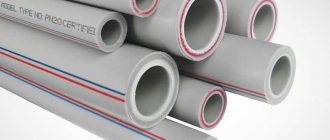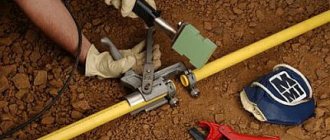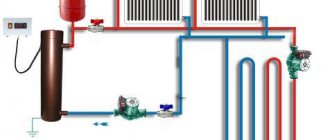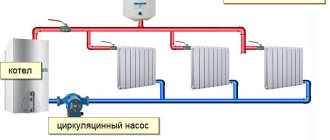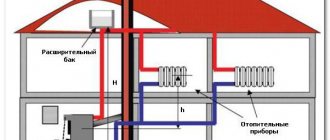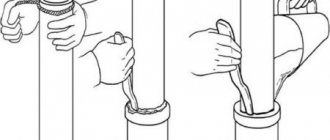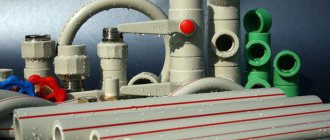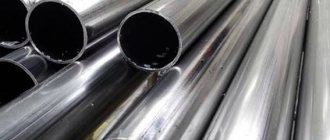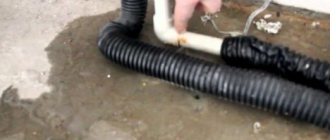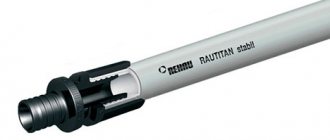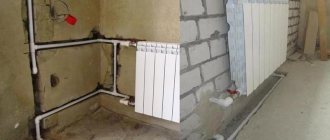What is cross-linked polyethylene
Crosslinked is polyethylene whose structure is modified at the molecular level. This improves technical and operational properties. During the crosslinking process, the molecular units are linked together and form a cellular three-dimensional network.
Areas of application
The material is used in the arrangement of:
- drinking water pipes;
- distribution of heating and hot water supply systems;
- pipelines for transporting gaseous media;
- underfloor heating systems;
- sewer communications;
- pipelines for supplying process water and compressed air;
- lines for supplying various chemical compositions.
Technical characteristics and properties
After cross-linking, polyethylene is not inferior in strength to many metal alloys and surpasses them in resistance to various destructive influences.
In addition, cross-linked polyethylene is characterized by:
- High density - 940 kg/m³.
- The operating temperature range is from 0 to +95 °C.
- Higher melting point - from +200 ºС.
- Ability to maintain impact resistance and crack resistance at temperatures down to -50 ºС.
- Thermal conductivity - 0.38 W/μ.
- Combustion starts at a temperature of +400 ºС. When burned, cross-linked polyethylene for heating does not emit toxic substances, but decomposes into carbon dioxide and water.
- Very high level of flexibility.
- Tensile strength - from 350 to 800%.
Life time
The service life of cross-linked polyethylene depends on operating conditions:
- In hot water supply systems at temperatures up to 70 ºС - 50 years.
- In underfloor heating structures and low-temperature heating systems through heating devices - 25 years.
- In high-temperature heating systems from heating devices - 10 years.
terms of Use
Cross-linked PE is intended for use in systems with operating pressure up to 20 atmospheres at a maximum temperature of 95 ºС with a permissible short-term increase of up to 110 ºС.
Pipelines made of cross-linked polyethylene must be protected from direct sunlight by protective covers when laid externally or embedded in the structural elements of the building.
Characteristics of cross-linked polyethylene pipes
To obtain a material with higher strength characteristics, polyethylene was processed under high pressure. As a result, the polyethylene molecules formed stronger cross-links.
To obtain a kind of “stitching” the following methods were used:
- Polyethylene was placed in an electromagnetic field and irradiated with electrons.
- The material was treated with peroxide.
- Polyethylene was treated with nitrogen compounds.
The result of each method was a durable and thermally stable polyethylene, which is quite suitable for use in individual and central heating systems, radiator and panel type, in hot and cold water supply systems, as well as for “warm floor” and “snow melt” systems. Polyethylene pipes obtained as a result of treatment with peroxides are of higher quality.
To operate cross-linked polyethylene pipes, certain requirements must be met:
- The maximum operating temperature is no more than 900C. However, in extreme cases, products made from cross-linked polyethylene can function for a certain time at temperatures up to 100 degrees.
- The working pressure in the system cannot be more than 10 bar, provided that the coolant is heated to 90 degrees, or 25 bar when the working environment is heated to no more than 25 degrees.
One of the features of cross-linked polyethylene is its high oxygen permeability. This property is a disadvantage of the material, as it limits its use in its pure form, especially in closed-type heating systems. To eliminate this drawback, cross-linked polyethylene is reinforced with a layer of aluminum foil or protected with a special polyvinylethylene coating.
Production Features
Polyethylene granules are loaded into an extruder, where they are heated to a molten state and homogenized. The molten mass is then forced through a round hole, forming into a tubular-shaped workpiece. Primary cooling of the workpiece occurs when passing through a vacuum chamber, after which the outer diameter of the product is formed. It is then cooled by air droplets or in a water bath. The cooled workpiece is marked and cut into pieces of standard length or wound into coils.
Pipe stitching method
Cross-linking of polyethylene for making pipes is carried out using several methods:
- Peroxide method. During the heating of polymer granules, hydrogen peroxide is introduced into the composition. The cross-linking level of the material reaches 85%. The resulting products are marked PE-Ha.
- Silane method. The material is treated with a chemical solution containing catalysts and an organic silane. The percentage of cross-linked molecules is 70%. Such pipes are marked with the abbreviation PE-Xb.
- Using electron beam irradiation technology. To form lateral bonds between the molecules of the polyethylene crystal lattice, finished products are exposed to radiation. Pipes of this type are called PE-Xs.
Advantages and disadvantages
Unlike conventional plastic pipes, products made from cross-linked polyethylene do not have thermoplasticity. They are able to withstand high temperatures without losing their shape. This property allows the use of cross-linked polyethylene for the installation of hot water supply systems, heating and heated floors.
In addition, cross-linked polyethylene has many other positive qualities:
- Absolutely resistant to corrosion.
- High strength.
- Light weight.
- Soundproofing properties.
- Resistant to pressure loads and temperature changes.
- High elasticity, due to which cross-linked polyethylene pipes do not crack when frozen. After the water thaws, they restore their shape.
- High technology.
- High wear resistance, especially to abrasion.
- Toxicological safety.
- The presence of the effect of reverse shrinkage, or “shape memory,” when a product, after changing its configuration, can quickly restore its original appearance.
- Resistant to the formation of lime and oxide deposits on the internal surfaces of pipes. During long-term operation, a heating system made of cross-linked polyethylene will completely maintain its throughput.
- Durability.
Despite such a large number of advantages, cross-linked polyethylene also has disadvantages:
- Excessive reaction to ultraviolet radiation.
- Due to their high plasticity, heating pipelines made of cross-linked polyethylene may sag over time.
- The likelihood of oxygen diffusion into the coolant, which can cause parts of heating devices to quickly corrode.
Advantages of polyethylene pipes for heating
Pipes made of cross-linked polyethylene have a large number of advantages, thanks to which they stand out from the general group of pipes used for the installation of heating systems. Among the particularly significant advantages are the following:
- High temperature resistance and excellent strength characteristics . Unlike polypropylene and conventional polyethylene heating pipes, the new material will not change its shape when exposed to high temperatures.
- Resistance to the formation of corrosion spots . Compared to copper products, cross-linked polyethylene pipes are not subject to corrosion. Moreover, this process does not occur either inside the structure of the material or on the surface.
- No build-up inside the pipes . The internal walls of PEX pipes are not covered with layers after transportation of any aggressive environment. This differs from most steel pipes, which after a certain period of time become less productive due to a decrease in flow velocity.
- Restoring the previous form . Many pipes lose their shape as a result of certain mechanical stress. However, cross-linked polyethylene pipes can expand or contract to certain parameters under the influence of low temperature or mechanical stress.
- Insignificant mass . The light weight of the material makes it more convenient to transport cross-linked polyethylene pipes and facilitates the installation process.
- Easy installation and great possibilities . PEX pipes can be laid in any pattern, including the formation of a loop or a large number of bends. Connection using fittings simplifies the installation process, as it eliminates the need to use welding equipment, soldering and gluing.
- Environmental Safety . Cross-linked polyethylene belongs to the group of environmentally friendly materials, so PEX pipes can be used to transport clean drinking water.
However, such pipes cannot be called completely flawless due to the presence of some shortcomings.
What is better for heated floors - cross-linked polyethylene or metal-plastic?
Cross-linked polyethylene as a material for installing heated floors significantly surpasses its analogues in its characteristics. Compared to metal-plastic and polypropylene, it can withstand higher operating temperatures and a longer service life.
Cross-linked polyethylene has shape memory, which is a definite plus when installing underfloor heating: a large number of bends in the contour can lead to creases in the metal-plastic material. In this case, you will have to cut out the deformed section and connect the pipes using fittings, which is extremely undesirable under screed conditions. A leak can also be caused by delamination of metal-plastic, which occurs when heated due to different coefficients of linear expansion of its layers.
Scope of application
On an industrial scale, pipes made of cross-linked polyethylene are of little use, since their diameter is limited to a maximum of 250 mm and limited ability to operate under increased loads. In individual construction, the use of cross-linked polyethylene is widely used in installation:
- heating communications;
- in cold and hot water supply.
Pipes made of cross-linked polyethylene are popular for installing heated floors. This material is easy to install, does not require special skills or complex equipment, is durable and reliable. For heating systems, only pipe materials with a protective layer are used.
When choosing pipes and fittings for installing water supply communications or heating systems, you should be guided by the manufacturers' recommendations, since the documentation always indicates the direction of use and acceptable operating parameters.
Note! All pipe products are marked in detail on the outside.
The label indicates:
- mode of production;
- release date (up to a week);
- wall thickness and diameter;
- acceptable operating parameters;
- quality control mark.
Each manufacturer offers fittings for mounting their products. The use of native materials is the key to reliable connections and long-term operation, since the production of pipes and fittings uses the same process.
Tips on how to choose
When purchasing cross-linked polyethylene pipes for heating, you should pay attention to:
- Stitching method. PE-Ha products cross-linked using the peroxide method are more suitable for heating systems. They have the highest degree of cross-linking, are more durable and less thermoplastic.
- Availability of anti-diffusion protection.
- Availability of ultraviolet protection.
- Correspondence of diameter and wall thickness to design data.
Popular manufacturers
The products made from cross-linked polyethylene from the following companies are in highest demand:
Rehau
The Rehau concern is a world leader in the production of polypropylene, metal-plastic and PEX pipes. The company uses the peroxide method to crosslink PE, and ethylene vinyl alcohol (EVAL) for the oxygen-protective layer. The range is represented by the following models:
- Rehau Rautitan Flex. Products for universal use. Can be used in heating systems of any type and water supply. They are gray in color and are available with or without factory insulation.
- Rehau rautitan HIS. Designed for the construction of cold and hot water supply lines, white.
- Rehau Rautitan Pink. Sewn by radiation method, dyed pink. Area of application: underfloor heating device.
- Rehau Rautherm S. Equipped with an oxygen barrier, used for heating systems, mainly for heated floors. Color - red.
- Rehau Raubasic Natur. Designed for use in communications with low operating pressure, there is no oxygen-protective layer. White color.
- Rehau Raubasic Eval. Equipped with anti-diffusion protection, they are used for the manufacture of water supply and heating pipelines with low pressure levels.
Uponor
The Finnish company Ononor produces high-tech pipes for water supply, floor and radiator heating, PE cross-linked using hydrogen peroxide (PE-Ha). They make it possible to transport hot water with temperatures up to +95 °C and pressures up to 10 bar.
Valtec (Italy)
The company uses high-density low-density polyethylene (HDPE) as a base. Crosslinking is carried out using the silane method. Valtec products can withstand constant heating up to 80 ºС, but do not have shape memory, so they are preferable for hidden installation.
BIR PEX (Birpex)
Cross-linked polyethylene made in Russia. It is made from English raw materials in accordance with the assortment, has good quality, and is cheaper than analogues of European brands.
approximate price
The cost of cross-linked polyethylene products is determined by the manufacturing company depending on the diameter, characteristics and production features. Its increase may also be affected by brand awareness. I will give approximate prices for several of the most common models from different manufacturers.
Production of cross-linked polyethylene
The initial raw material for the production of cross-linked polyethylene is the simplest gaseous hydrocarbon, ethylene. It consists of 2 carbon molecules and 4 hydrogen molecules. Polyethylene is produced through polymerization (a reaction during which ethylene molecules are linked together into long hydrocarbon chains with identical “CH2” units). The material is a transparent thermoplastic substance that is widely used to produce, for example, household plastic bags.
In industrial production, polyethylene is produced in granular form. This material melts easily and becomes soft already at 40 degrees. Without further processing, it is impossible to obtain strong heating pipes from polyethylene.
To produce a particularly durable material (cross-linked polyethylene), plain polyethylene is subjected to further chemical and physical attack.
Cross-linked polyethylene is a material in which long chains of molecules are equally oriented and connected to each other by additional lateral bonds. These bonds occur instead of a pair of hydrogen atoms taken from the polymeric hydrocarbon molecule ethylene. The more such lateral bonds, the more resistant the cross-linked polyethylene is to external influences.
Note! The number of stitching bonds formed directly depends on the stitching method.
There are many ways to remove hydrogen atoms from the ethylene polymer molecule. The reaction was first carried out by a Swedish chemist back in the last century, but he considered that the resulting substance had no practical use. The technology was bought from the author by a Swedish company, which labeled its product as PEX. Consumers still know cross-linked polyethylene under this label today.
We recommend that you read: PVC pipes for swimming pool equipment
There are about 15 ways to stitch polyethylene. Today, 3 methods of producing cross-linked organic polymers are used on an industrial scale:
- PEX-A. Treatment of polyethylene with peroxide. The reaction is carried out at elevated pressure and constant temperature control. Peroxide, being an oxidizing agent, during decomposition takes away hydrogen atoms from polymers, forcing carbon atoms to form bonds with each other. As a result, a three-dimensional network of very long chain molecules is formed, in which up to 85% of carbon atoms have lateral bonds with a neighboring molecule. Crosslinking polyethylene with peroxide is the most effective method. However, the features of the technological process increase the cost of the output material.
- PEX-B. Pipes of this brand are produced in two stages. At first, silane is introduced into polyethylene. At the second stage, the product is saturated with water in the presence of a catalyst. The result is cross-linked polyethylene, with a percentage yield of additional bonds of 65%.
- PEX-C. Cross-linking of polyethylene by radiation. Here it is important to monitor the spatial orientation of the product relative to the radiation source. The share of bond formation is about 60%.
Until recently, nitrogen cross-linking (PEX-D) was used to produce cross-linked polyethylene pipes. Now the share of such pipes on the market has disappeared.
Note! Pipes made of cross-linked polyethylene differ not only in price, but also in performance characteristics, depending on the technology used to produce them.
Step-by-step installation of heated floors
Underfloor heating technology consists of creating a multi-layer structure, each layer of which is laid in strict sequence. The thickness of this structure depends on the type of insulation and mortar, as well as the presence of reinforcement.
Preparatory work before construction
Before installing a heating system made of cross-linked polyethylene, the following preparatory work must be completed:
- prepare tools;
- remove old flooring and screed;
- clean the floor surface from dust and dirt;
- determine the diameter of pipes and connecting parts;
- buy related materials and equipment.
In addition to the cross-linked polyethylene pipes themselves, the design of underfloor heating consists of several more mandatory elements:
- water heater for heating the coolant;
- expansion tank;
- a special pump or pump that provides forced circulation of the coolant;
- distribution manifold unit;
- a set of control, shut-off and connecting fittings, for example ball valves, fittings, etc.;
- insulation material;
- reinforcing mesh;
- fasteners for fixing insulation boards and heating pipelines made of cross-linked polyethylene;
- damper tape;
- cement-sand mortar or concrete mixture.
Selecting and creating a pipe laying scheme
Heated floor contours can be laid according to several schemes:
- A spiral offset to the center. This is the most common method of laying cross-linked polyethylene, ensuring uniform distribution of thermal energy: in a spiral pattern, supply sections alternate with return sections. Laying cross-linked polyethylene pipes begins around the perimeter of the room and ends in the center of the floor. Heating of the floor near the outer walls is more intense, which makes it possible to install a boiler of lower power without reducing the degree of coolant output.
- Snake. Snake laying is done from one wall to the opposite in several turns. Enhanced heating of the floor is provided at the beginning of its path; as it moves away, the water cools and heats the surface with less intensity.
- Double spiral. With this option, the heating circuit is divided into two spirals. The first is adjacent to the outer wall. The coolant passes through it and enters the second, the main spiral.
When choosing an installation diagram for underfloor heating, you need to take into account the size of the rooms. For small rooms, for example, a bathroom or a corridor, you can use snake laying. A cross-linked polyethylene circuit in the form of a double spiral is convenient for heating large areas or when it is necessary to heat certain areas of the room with different intensities, for example in front of the front door.
Calculation of the number of pipes
There are a number of rules that will help you calculate the future underfloor heating circuit:
- A pipeline made of cross-linked polyethylene with a cross-section of 16 mm should be no more than 100 m long. The length of a circuit made of pipes with a cross-section of 20 mm should not exceed 120 m. If these indicators increase, the pressure in the system will be too low.
- If a system made of cross-linked polyethylene has several contours, then they should be equal in length or differ minimally.
- With sufficient insulation, sections of the heating pipeline should be located in increments of 15 cm. In northern regions, where in winter the thermometer can drop below -20 ºС, the increment should be reduced to 10 cm.
On average, the consumption of cross-linked polyethylene pipes per 1 m² with a step of 15 cm should be 6.7 meters, with a step of 10 cm - about 10 meters. To more accurately determine the length of the contour, you need to divide the area of the room by the size of the laying step. The resulting value should be increased by the size of the bends and the length of the distance to the collector assembly.
Features of the material
Cross-linked polyethylene has a three-dimensional mesh structure with large cells. This unique structure explains its differences from other polymer materials.
Note! Pipes marked PEX-A have the best characteristics. Alternative production technologies are used to reduce the price of finished products.
Pipe Features:
- Preservation of unchanged qualities at sub-zero temperatures. You can work with cross-linked polyethylene pipes at temperatures down to -20 degrees.
- The ability to take its original shape after a deforming effect (the presence of molecular structural memory).
- Resistant to organic solvents, acids and alkalis. The exception is 50% nitric acid.
- The material begins to melt at 200 degrees; for combustion it requires a temperature twice as high.
We recommend that you read: How to independently build a columnar foundation from PVC pipes - step-by-step instructions
Manufacturers, to improve the performance of heating pipes made of cross-linked polyethylene, produce multilayer or reinforced products:
- Multilayer pipes have an additional layer to protect the inside of the pipeline from the penetration of atmospheric oxygen. In three-layer products it is located on the outside and is attached to the polyethylene with an adhesive layer. In five-layer pipe products, the anti-oxygen protection is located in the middle.
- Reinforced cross-linked polyethylene products are formed on a frame made of nylon thread, aluminum foil or Kevlar (a special high-strength fiber). They have increased strength to bending, twisting, pressure (up to 30 atm.), and water hammer.
Preparing the base for pipes
The floor surface, cleared of the old coating, must be leveled with a sand mixture followed by compaction or a self-leveling compound so that the size of the differences is no more than 5°. To check the evenness, you can use a building level.
The next stage is laying a waterproofing layer of polyethylene or foil film. The sheets of waterproofing material are laid overlapping, the edges and joints are secured with reinforcing tape. A layer of thermal insulation is installed on top. It will redirect the heat flow upward and eliminate its loss through the ceiling. The following can be used as insulation:
- extruded polystyrene foam;
- Styrofoam;
- cork substrates;
- basalt mineral wool.
Extruded polystyrene foam boards are absolutely vapor-tight, have high strength, and can withstand significant mechanical loads. When installing underfloor heating, you can simply connect them together with tongue-and-groove ends and fill the gaps with pieces of insulation and special glue.
Mineral wool and foam plastic are less resistant to deformation under mechanical loads, so they should be laid between wooden or metal slats.
Hygroscopic cork materials and mineral wool require an additional layer that will provide them with vapor and waterproofing. In this case, vapor barrier membrane sheets are overlapped on the insulation, sealing the edges and joints with tape, and the reinforcing mesh is secured with stop brackets at intervals of 50 cm from each other over the entire floor area. It will increase the rigidity of the structure.
Next, a damper tape is laid around the perimeter of the room, compensating for the thermal expansion of the concrete screed when the heating is running. The height of the tape should cover the thickness of the insulation layer, cross-linked polyethylene hoses and reinforced screed.
Installation technology
When installing PE-X pipes, you will not need a welding machine or workers, unlike installing metal analogues. All you need is a well-designed system diagram and precise execution of instructions.
ATTENTION! If you do not have experience in piping planning, it is best to consult with a qualified professional. The diagram must include dimensions and distances between nodes.
After the drawing is ready, start drawing up an estimate, in which you must calculate the amount of material needed. Consider what diameter pipes you will need for this or that purpose, since sections can vary between 1–16 cm.
Before carrying out a thermal calculation, decide what kind of climate system you want to install and what materials you will need. Products made from cross-linked polyethylene are used to create various types of systems: warm floors, radiator and combined systems. Professionals advise choosing the last option, which allows you to create an atmosphere of warmth and comfort in the room.
There are two options for installing polyethylene pipes: using press-on or compression fittings.
“Fittings” mean various connectors that are used when installing pipes (elbows, couplings, tees, etc.). They are capillary, compression, threaded and press-on.
Installation of polyethylene pipes
After preparing the base you need:
- install the heating boiler and manifold;
- connect the equipment to the water supply.
After this, you can lay cross-linked polyethylene according to the chosen pattern. For convenience, marking the outline of the structure can be applied directly to the insulation.
Next, one end of the cross-linked polyethylene hose is connected to the outlet pipe of the manifold, the contour lines are laid out and secured to the mesh with tightening clamps every 30–50 cm in straight sections, in increments of 10–20 cm in places of bend. After laying the circuit, the other end of the product is connected to the manifold using a fitting.
When working with cross-linked polyethylene, you need to:
- Avoid sharp bends of the material in places where the pipeline turns.
- Carry out installation at temperatures not lower than +18 ºС. Polyethylene products should be brought into the room from the cold, wait until they warm up to room temperature, and only then install them.
- Ensure that the installation is even, and do not allow the hose to twist or put excess tension on it.
- When installing, try not to step on pipe materials made of cross-linked polyethylene, and do not place tools or heavy things on them.
- Reinforce polyethylene connections with thermal insulation for connection to the collector unit, since they are not located in the screed.
The assembled heating system must be tested before it is closed with a screed by pouring coolant into it for 6–10 hours. If during this time it is completely filled with coolant and remains sealed, then you can fill the screed.
Advantages and disadvantages
When choosing materials for installing a heating system, it is important to weigh all the advantages and disadvantages of pipe materials offered on the market. Compared to classic metal, polymer pipes are favored by their price, corrosion resistance and ease of installation.
Advantages:
- High elasticity will not allow the pipe to burst, even if the system freezes when filled with water.
- The weight of the pipe is from 1 to 1.5 kg per linear meter, which makes transportation easy and installation convenient.
- Ideally withstand the loads of individual water heating. A temperature of 95 degrees and low pressure will allow your system to operate smoothly for more than 50 years.
- The smoothness of the inner wall protects the system from the formation of scale and deposits of suspended particles. This means that heating pipes will not become clogged over time.
- Flexibility and high elasticity allow you to install a “warm floor” system without the use of fittings. This reduces the cost of installation and allows you to maintain the original integrity of the pipeline, which is the main condition for closed heating systems.
- Corrosion resistance.
- Resistance to pressure drops within 10 atm.
The disadvantages include:
- Rapid destruction of the material when exposed to sunlight.
- The ability of polyethylene to pass atmospheric oxygen through the walls, which significantly increases the rate of destruction of the metal parts of the pipeline.
- Hard water can clog heating pipes over time. To prevent such contamination, it is recommended to install mineral filters at the inlet. This is especially important for hot water supply. For the heating system, it is enough to fill it with softened, purified water.
- High price of large diameter pipes.
We recommend that you read: Transparent plastic pipe in modern piping systems
Screed rules
The screed can be made from ready-made cement-sand mortar grade 400 with plasticizers or a self-prepared mixture of cement and sand. Its thickness should be at least 3 cm higher than the laid cross-linked polyethylene. Additional strength is given to the screed using a metal or plastic mesh with a cell size of 10x10 cm. It should not just lie on top of the cross-linked polyethylene pipework, but be located inside the solution layer.
If the room area is more than 33 m² or has a complex configuration, then the screed should be made with expansion joints that break the floor into smaller rectangles. They will avoid cracking of the screed during heating.
Basic rules to follow when installing a screed:
- Work can only be performed at positive temperatures, even if special additives are added to the composition to increase frost resistance.
- While pouring the solution and until it dries completely (after 20–25 days), the pressure in the pipes should be about 1.5–2 atmospheres, and the coolant temperature should not exceed 25 ºС.
- The screed is poured after plastering the walls.
- To set the level of the future floor, you need to use special metal beacons.
The finishing finish on top of the underfloor heating screed can be made from any material.
Technical characteristics of cross-linked polyethylene
The optimal operating temperature in heating systems is 90 degrees at 6 atmospheres of operating pressure. These parameters guarantee a pipeline service life of up to 50 years.
Note! For comparison, ordinary polyethylene begins to deform at temperatures above 40 degrees.
The maximum coolant temperature is up to 120 degrees (without negative consequences), the minimum is -50 degrees. Moreover, due to the elasticity of the material, cross-linked polyethylene pipes are not destroyed by the expansion of water frozen in them. They have proven themselves excellent in classic water heating of an individual home. Here, the temperature regime and pressure (small) contribute to their long-term trouble-free operation.
Note! Polyethylene pipes cannot be used with a steam heating system.
Technical characteristics of a cross-linked polyethylene pipe with a minimum diameter (16 mm):
- weight per linear meter 110 g;
- pipe wall 2mm;
- the volume of liquid that 1 meter of communications contains during operation is about 113 ml;
- polyethylene density 940 kg/m³;
- thermal conductivity - 0.39 W/mK.
Cross-linked polyethylene lights up at a temperature of about 400 degrees, and at 200 degrees it begins to melt.
There are three-layer and five-layer pipes. The multilayer nature of polyethylene pipes is explained by their instability to ultraviolet radiation and the ability to transmit oxygen. Operating unprotected pipes in the light leads to their rapid wear. The ability to transmit oxygen makes polyethylene communications dangerous for steel elements. Oxygen is a strong oxidizing agent and leads to active corrosion of metals.
Three-layer pipes have the following structure:
- inner polyethylene layer;
- glue;
- protective layer – oxygen barrier.
We recommend that you read: Features of a ceramic chimney and its installation technology
Five-layer ones have two layers of glue, two (inner and outer) layers of polyethylene and in the middle a protective layer against the penetration of oxygen. Accordingly, the more complex the pipe structure, the more reliable its protection and the higher the price.
Commissioning of the system
You can start operating the heating system at full capacity only after the screed has completely hardened.
Underfloor heating made of cross-linked polyethylene is put into operation in the following sequence:
- Connection to the flow and return line manifold.
- Opening all circuits simultaneously using taps on the manifold unit.
- Opening of air vent valves.
- Starting the circulation pump.
- Setting the desired temperature.
- Raising the pressure in the system to the operating value.
- Shutting down all circuits except the longest.
- Recording data on the flow meter and balancing devices.
- Connecting the next heating circuit along the length and adjusting the pressure level according to the operation data of the first circuit.
- Connecting and balancing the following circuits.
How competently you assembled the heating system will become clear after 2–3 months of constant use.
Flaws
Firstly, when connecting cross-linked polyethylene pipes for heating using brass fittings, the list of materials used for screed or plaster is limited. It is better to exclude those that can cause corrosion of the fitting, so as not to reduce the quality of the system.
Secondly, cross-linked polyethylene pipes are characterized by low resistance to ultraviolet radiation, so it is better to use them in closed systems and communications.
Third, it is recommended that PEX pipes be used in systems that have pressure and temperature ratings that meet the pipe thresholds. When choosing pipes made of cross-linked polyethylene, you should carefully study the technical characteristics of the overall system and the features of the living space where you plan to install a heating system from the specified material.
The practical use of cross-linked polyethylene for heating shows that the material fully complies with the parameters and conditions of modern systems that function flawlessly on Russian territory.

